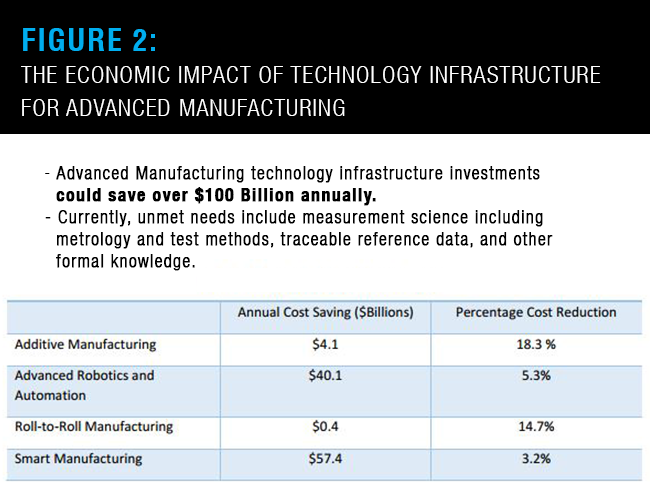U.S. Manufacturing Cannot Afford to Wait on Increased Investments in Infrastructure
There is no question that deteriorating transportation infrastructure is having a negative impact on the U.S. economy.

“The nation’s manufacturers bear the brunt of the costs from substandard roads via reduced productivity, foregone sales, and costly contingency plans needed to account for unpredictable deliveries resulting from road congestion,” states Ike Brannon, president of Capital Policy Analytics, and Mike Gorman, professor of transportation and logistics at the University of Dayton, in a recent Bloomberg article.
With increasing global competition, especially from low-cost countries, U.S. manufacturers must be competitive. Money saved through more efficient operations will mean little if products cannot get to market, or raw materials cannot be received, via a reliable and modern transportation infrastructure. For example, it’s estimated that road congestion alone costs U.S. businesses at least $100 billion a year.
“Without a robust infrastructure network, manufacturing suffers and America falls behind our foreign competitors,” states Jay Timmons, president and CEO of the National Association of Manufacturers (NAM). “Investing in infrastructure is investing in our future. There is no excuse for policymakers to abdicate this responsibility while other countries outpace us.”
Transportation Infrastructure
If ports are jammed up, trucks delayed, or power is down, productivity and customer service are impacted significantly. “Across the manufacturing sector, transportation logistics matter, and congestion is waste that drives the consumer’s cost up like a hidden tax,” Mary Andringa, chairperson of the board for Vermeer Corporation, a heavy equipment manufacturer, told the U.S. House Transportation and Infrastructure Committee in February 2017.
She added that the U.S. has fallen behind many global competitors and is ranked at 11th in infrastructure quality. “China,” she adds, “is spending more on infrastructure each year than North America and Western Europe combined.”
To spur infrastructure growth, NAM recently put together its “Building to Win” initiative, recommending that policymakers act on the following issues:
- Relieve highway bottlenecks and repair America’s crumbling highways and bridges
- Upgrade airports, runways, and air traffic management technology
- Deepen ports, upgrade aging locks, and enhance intermodal connections
- Invest in Amtrak and incentivize private capital reinvestment in our railroads
- Streamline regulations to reduce the cost of delayed infrastructure
- Promote new energy infrastructure investments
- Expand cutting-edge broadband communications infrastructure
Advanced Manufacturing Infrastructure
The U.S. is a global leader in advanced manufacturing, which relies on integrated, high-tech processes such as automation and robotics to manufacture parts and products. Recognizing the competitive importance of advanced manufacturing, the Obama Administration created the National Network for Manufacturing Innovation Institutes to further develop these technologies.
However, according to the Information Technology & Innovation Foundation, strong investment in infrastructure that supports advanced manufacturing has yet to take off. “Broadly, it seems innovation-based growth has stalled except in software,” states the foundation. “Filling potholes and repairing sewers will do nothing to address these deeper problems.”
The U.S. National Institute of Standards and Technology (NIST) has also conducted research to identify the economic benefits of developing advanced manufacturing technology infrastructure. NIST identified the following four advanced manufacturing sectors that could save $100 billion with infrastructure improvements:

For the U.S. to achieve long-term and sustainable manufacturing growth, government and industry must also invest in innovation infrastructure, advises Has Patel, president of Infologic, an R&D and technology consulting firm. “The nations that adapt such policies and strategically start this journey toward ‘innovation infrastructure’ will earn long-term advantages in terms of GDP and productivity growth, competitive advantages, and innovation leadership,” he states.
Infrastructure and Security
According to Christian Caballero, a public policy advisor and White House fellow, an overlooked issue regarding infrastructure and manufacturing is domestic national security. “Despite the emphasis on the economic impact that infrastructure development will have on manufacturing, manufacturers and companies involved in infrastructure development are on the front lines of the nation’s effort to improve our emergency preparedness. All efforts to develop a more permanent solution to our infrastructure and our emergency preparedness must include the significant participation of manufacturers.”
Caballero notes the U.S. Department of Homeland Security (DHS) has identified manufacturing sectors that are critical to America’s ability to defend and respond to threats and disasters. These include energy, iron and steel, aluminum, power transmission equipment, aviation and aerospace, and railroad rolling stock manufacturing—all of which must be supported by modernized infrastructure.
The price tag varies. The American Society of Civil Engineers estimates that upgrading U.S. surface transportation infrastructure alone will exceed $1 trillion; Andringa told the U.S. Congress $3.6 trillion for all infrastructure projects.
Duke University’s Center on Globalization, Governance and Competitiveness found that a long-term infrastructure investing plan worth $114 billion annually could create as many as 2.5 million jobs a year.
However, without immediate action, these jobs will be lost and U.S. competitiveness undermined. NAM’s call to action—“Building to Win”—“is a blueprint for the Trump administration to “repair our roads, bridges, rails, airports, ports, and waterways, keep pace with our energy infrastructure needs, and revolutionize the infrastructure that makes the American Dream possible,” states NAM.
- Category:
- Industry
- Manufacturing
Some opinions expressed in this article may be those of a contributing author and not necessarily Gray.
Related News & Insights
Manufacturing
The New Face of Manufacturing: Promising Innovations that Could Revolutionize Infrastructure
GrayWay
Manufacturing
Is One of America’s Oldest Modes of Transportation Part of the Solution to Its Infrastructure Woes?
GrayWay
Manufacturing
Gray Construction CEO Stephen Gray Discusses How Innovations in Infrastructure Will Boost Manufacturing
Industry
February 09, 2016